Dorsoventral Arrangement of Lateral Hypothalamus Populations in the Mouse Hypothalamus: a Prosomeric Genoarchitectonic Analysis
- PMID: 36357614
- PMCID: PMC9849321
- DOI: 10.1007/s12035-022-03043-7
Dorsoventral Arrangement of Lateral Hypothalamus Populations in the Mouse Hypothalamus: a Prosomeric Genoarchitectonic Analysis
Abstract
The lateral hypothalamus (LH) has a heterogeneous cytoarchitectonic organization that has not been elucidated in detail. In this work, we analyzed within the framework of the prosomeric model the differential expression pattern of 59 molecular markers along the ventrodorsal dimension of the medial forebrain bundle in the mouse, considering basal and alar plate subregions of the LH. We found five basal (LH1-LH5) and four alar (LH6-LH9) molecularly distinct sectors of the LH with neuronal cell groups that correlate in topography with previously postulated alar and basal hypothalamic progenitor domains. Most peptidergic populations were restricted to one of these LH sectors though some may have dispersed into a neighboring sector. For instance, histaminergic Hdc-positive neurons were mostly contained within the basal LH3, Nts (neurotensin)- and Tac2 (tachykinin 2)-expressing cells lie strictly within LH4, Hcrt (hypocretin/orexin)-positive and Pmch (pro-melanin-concentrating hormone)-positive neurons appeared within separate LH5 subdivisions, Pnoc (prepronociceptin)-expressing cells were mainly restricted to LH6, and Sst (somatostatin)-positive cells were identified within the LH7 sector. The alar LH9 sector, a component of the Foxg1-positive telencephalo-opto-hypothalamic border region, selectively contained Satb2-expressing cells. Published studies of rodent LH subdivisions have not described the observed pattern. Our genoarchitectonic map should aid in systematic approaches to elucidate LH connectivity and function.
Keywords: Genoarchitecture; Patterning; Peduncular hypothalamus; Prosomeres.
© 2022. The Author(s).
Conflict of interest statement
The authors declare no competing interests.
Figures

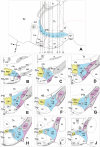
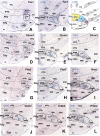

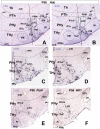

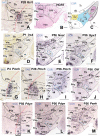
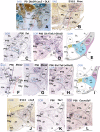


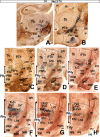
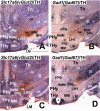
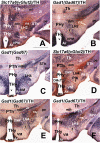



Similar articles
-
Regionalized differentiation of CRH, TRH, and GHRH peptidergic neurons in the mouse hypothalamus.Brain Struct Funct. 2014 May;219(3):1083-111. doi: 10.1007/s00429-013-0554-2. Epub 2013 Apr 30. Brain Struct Funct. 2014. PMID: 24337236 Free PMC article.
-
Hypocretin/orexin- and melanin-concentrating hormone-expressing cells form distinct populations in the rodent lateral hypothalamus: relationship to the neuropeptide Y and agouti gene-related protein systems.J Comp Neurol. 1998 Dec 28;402(4):460-74. J Comp Neurol. 1998. PMID: 9862321
-
Co-localization of hypocretin-1 and leucine-enkephalin in hypothalamic neurons projecting to the nucleus of the solitary tract and their effect on arterial pressure.Neuroscience. 2013 Oct 10;250:599-613. doi: 10.1016/j.neuroscience.2013.07.054. Epub 2013 Jul 30. Neuroscience. 2013. PMID: 23912034
-
Local network regulation of orexin neurons in the lateral hypothalamus.Am J Physiol Regul Integr Comp Physiol. 2011 Sep;301(3):R572-80. doi: 10.1152/ajpregu.00674.2010. Epub 2011 Jun 22. Am J Physiol Regul Integr Comp Physiol. 2011. PMID: 21697524 Review.
-
Lateral hypothalamus as a sensor-regulator in respiratory and metabolic control.Physiol Behav. 2013 Sep 10;121:117-24. doi: 10.1016/j.physbeh.2013.03.023. Epub 2013 Apr 3. Physiol Behav. 2013. PMID: 23562864 Free PMC article. Review.
Cited by
-
The Blue Light-Responsive Lateral Pathway of the Retinohypothalamic Tract Promotes Endocannabinoid-Driven Modulation of Orexin Neurons.J Neurochem. 2025 Jun;169(6):e70137. doi: 10.1111/jnc.70137. J Neurochem. 2025. PMID: 40542554 Free PMC article.
-
The expression of transcription factors in the human fetal subthalamic nucleus suggests its origin from the first hypothalamic prosomere.Brain Struct Funct. 2025 Jan 20;230(2):33. doi: 10.1007/s00429-025-02893-w. Brain Struct Funct. 2025. PMID: 39831906
-
Can We Explain Thousands of Molecularly Identified Mouse Neuronal Types? From Knowing to Understanding.Biomolecules. 2024 Jun 15;14(6):708. doi: 10.3390/biom14060708. Biomolecules. 2024. PMID: 38927111 Free PMC article. Review.
-
Anti-obesity compounds, Semaglutide and LiPR, and PrRP do not change the proportion of human and mouse POMC+ neurons.PLoS One. 2025 Aug 13;20(8):e0329268. doi: 10.1371/journal.pone.0329268. eCollection 2025. PLoS One. 2025. PMID: 40802598 Free PMC article.
-
Critical test of the assumption that the hypothalamic entopeduncular nucleus of rodents is homologous with the primate internal pallidum.J Comp Neurol. 2023 Nov;531(16):1715-1750. doi: 10.1002/cne.25536. Epub 2023 Sep 11. J Comp Neurol. 2023. PMID: 37695031 Free PMC article.

